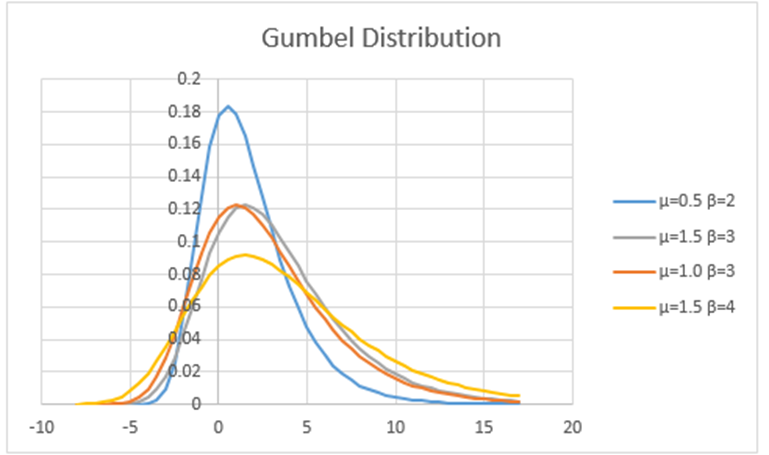Objective
We use the Gumbel distribution to model the largest value from a relatively large set of independent elements from distributions whose tails decay relatively fast, such as a normal or exponential distribution. As a result, it can be used to analyze annual maximum daily rainfall volumes. In this way, it can be used to predict extreme events such as floods, earthquakes, or hurricanes.
For this reason, the Gumbel distribution is also called the extreme value type I distribution and is used to find a maximum extreme value. Setting x to –x will find the minimum extreme value.
Properties
The pdf of the Gumbel distribution with location parameter μ and scale parameter β is
where β > 0. The cdf is
The inverse of the Gumbel distribution is
The standard Gumbel distribution is the case where μ = 0 and β = 1.
The Gumbel distribution is sometimes called the double exponential distribution, although this term is often used for the Laplace distribution.
Key statistical properties of the Gumbel distribution are:
 Figure 1 – Statistical properties of the Gumbel distribution
Figure 1 – Statistical properties of the Gumbel distribution
Here, γ is the Euler-Mascheroni constant whose value is –ψ0(1), the negative of the digamma function at 1 (see MLE Fitting Gamma Distribution) with a value approximately equal to .577215665.
Graphs
Figure 2 shows a graph of the Gumbel distribution for different values of μ and β.
Figure 2 – Chart of the Gumbel distribution
Worksheet Functions
Real Statistics Functions: The Real Statistics Resource Pack provides the following functions for the Gumbel distribution.
GUMBEL_DIST(x, μ, β, cum) = the pdf of the Gumbel distribution f(x) when cum = FALSE and the corresponding cumulative distribution function F(x) when cum = TRUE.
GUMBEL_INV(p, μ, β) = the inverse of the Gumbel distribution at p
Relationship with other distributions
Property 1: If x ∼ Weibull(α, β) then β(1 – α ln(x/α)) ∼ Gumbel(α, β)
It also follows that if x ∼ Gumbel(μ, β) then β exp(-(x-μ)/(βμ)) ∼ Weibull(μ, β)
Property 2 (Fisher-Tippett-Gnedenko): If {x1, …, xn} is a random sample from a standard normal distribution and x(n) is the maximum value from this sample (i.e. the nth order statistic), then x(n) ∼ Gumbel(μ, β) where
μ = NORM.S.INV(1 – 1/n) β = NORM.S.INV(1 – 1/(ne)) – μ
Example 1: What is the expected maximum value of a sample of size 10 taken from a normal distribution with mean 1 and standard deviation 2?
If {x1, …, x10} is such a random sample, then {z1, …, z10}, where zi = (xi–1)/2, comes from a standard normal distribution. The maximum of the original series x(10) = 2z(10) + 1.
By Property 2, we know that z(10) has a Gumbel distribution with
μ = NORM.S.INV(1 – 1/10) = 1.281552
β = NORM.S.INV(1 – 1/(10e)) – μ = 1.789242 – 1.281552 = .507690
Thus, the mean of z(10) is equal to
μ + βγ = 1.2881552 + .507690 ⋅ .577215665 = 1.574598
and so the expected value of the largest value in the original sample is
mean of x(10) = 2⋅ mean of z(10) + 1 = 2⋅ 1.574598 + 1 = 4.149197
Property 3: If x and y are independent, x ∼ Gumbel(μx, β) and y ∼ Gumbel(μy, β) then y – x ∼ Logistic(μy–μx, β)
Property 4: If x has a Weibull distribution, then -ln(x) has a Gumbel distribution.
Property 5: If x has an exponential distribution with mean 1, then ln(x) ∼ Gumbel(0,1).
Examples Workbook
Click here to download the Excel workbook with the examples described on this webpage.
References
Wikipedia (2020) Gumbel distribution
https://en.wikipedia.org/wiki/Gumbel_distribution
Hastings, N., Peacock, B. (2011) Statistical distributions. 4th Ed, Wiley
https://www.wiley.com/en-us/Statistical+Distributions%2C+4th+Edition-p-9780470390634

Dear Prof. Zaiontz
I’m sorry to intrude upon you, and I am from Lanzhou University. I am Fanyu Zhang. My research focuses on landslides.
I want to use your Gumbel distribution Excel tool to analyze the history of rainfall data for its recurrence period.
I am looking forward to your reply.
My email is zhangfy@lzu.edu.cn
Best regards
Fanyu
Hello Fanyu,
I am pleased that you have chosen to use the Real Statistics software to perform your research about landslides.
Do you have a specific question that I can help you with?
Charles